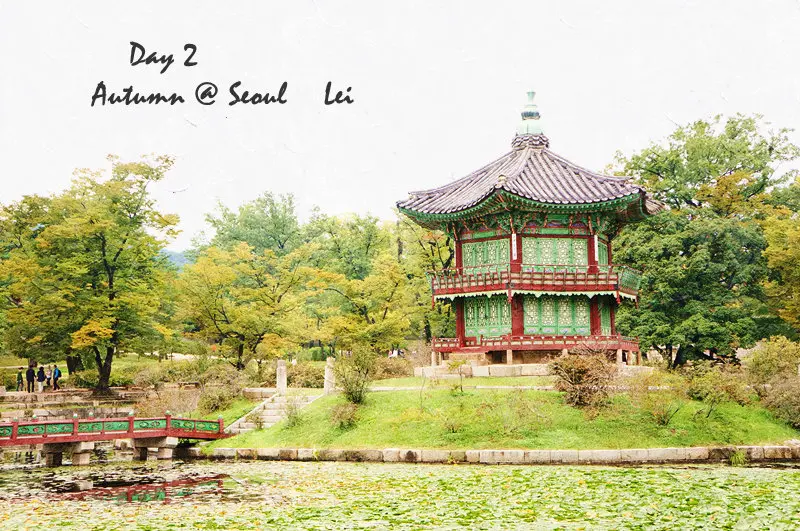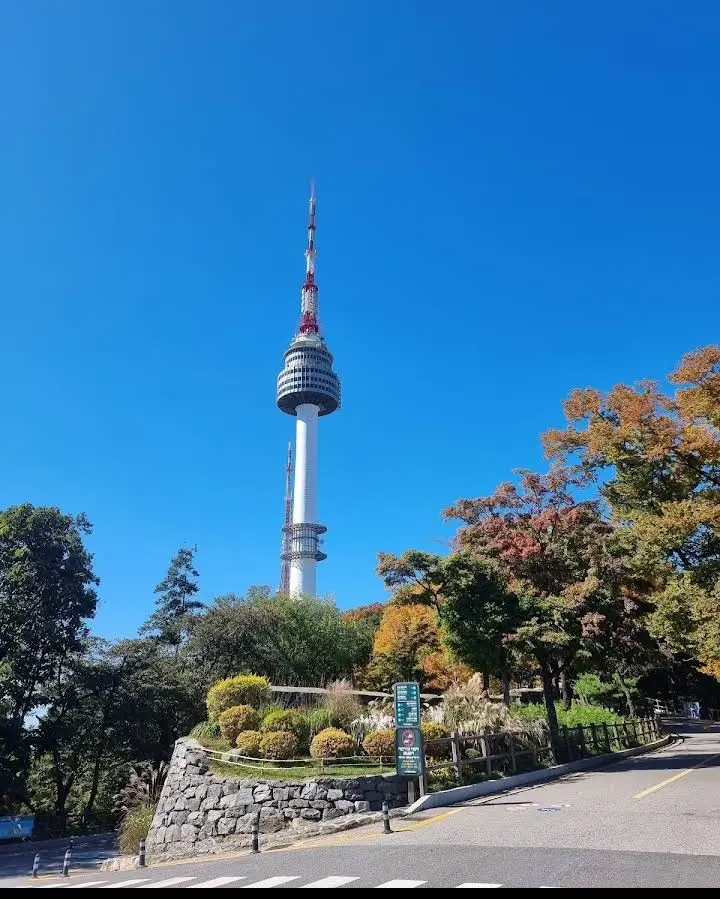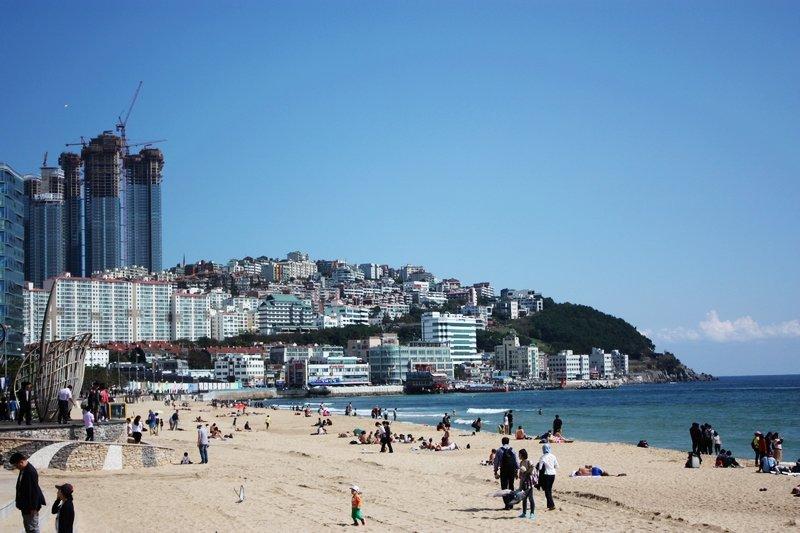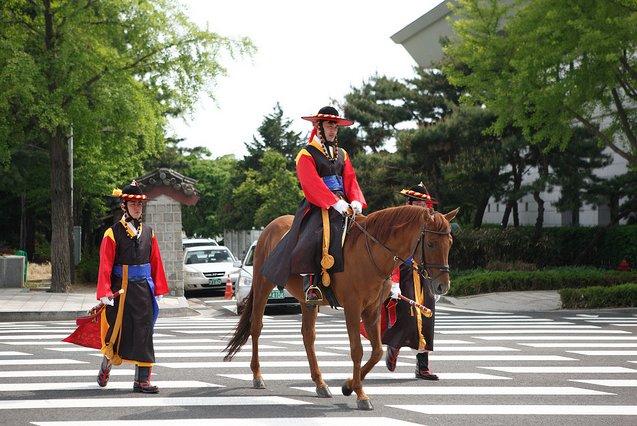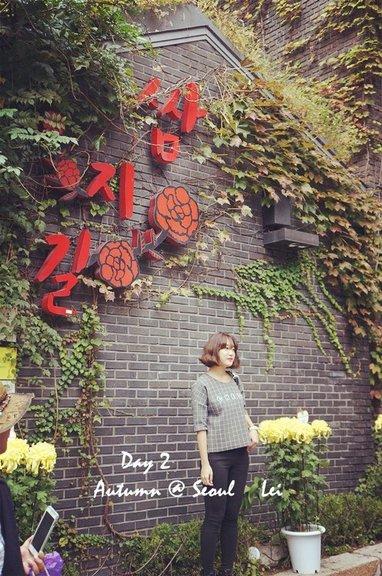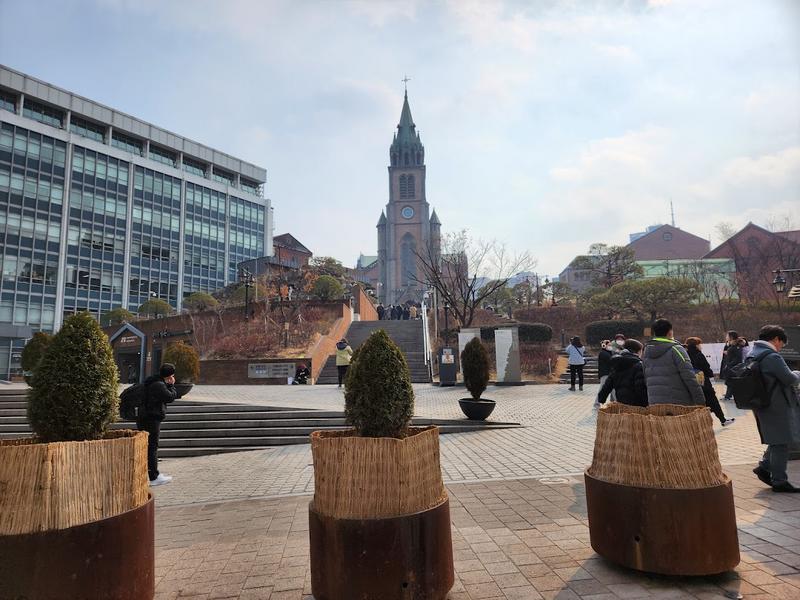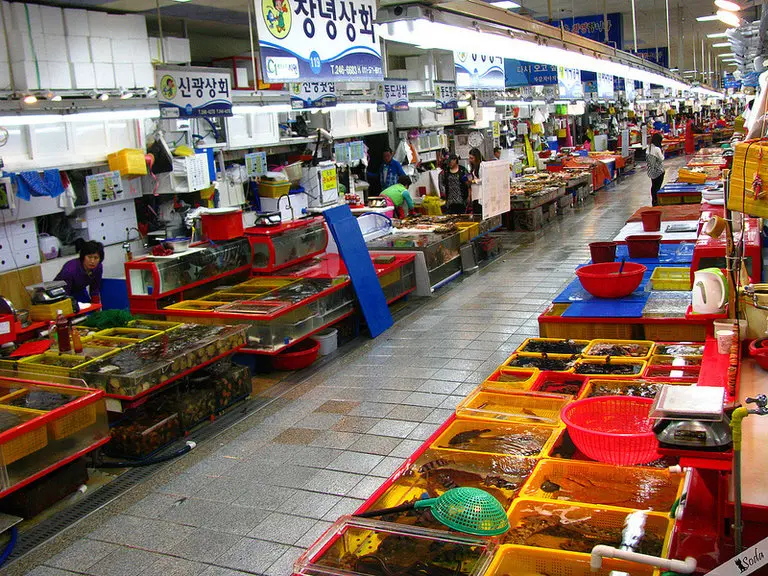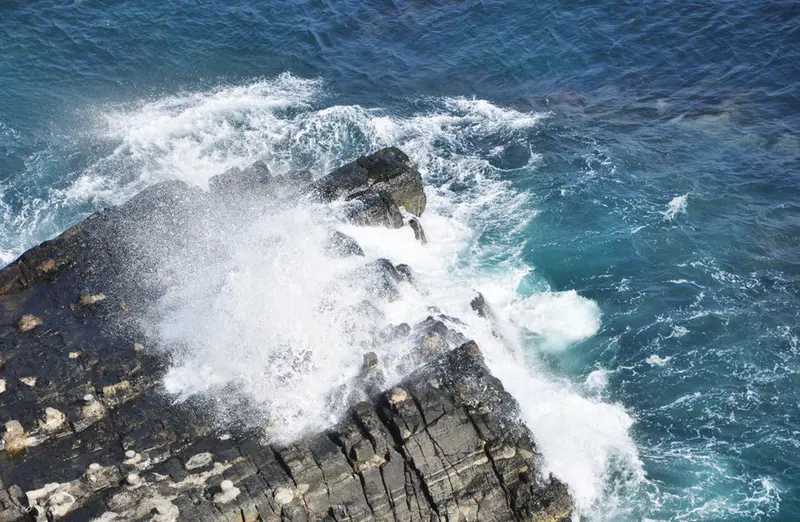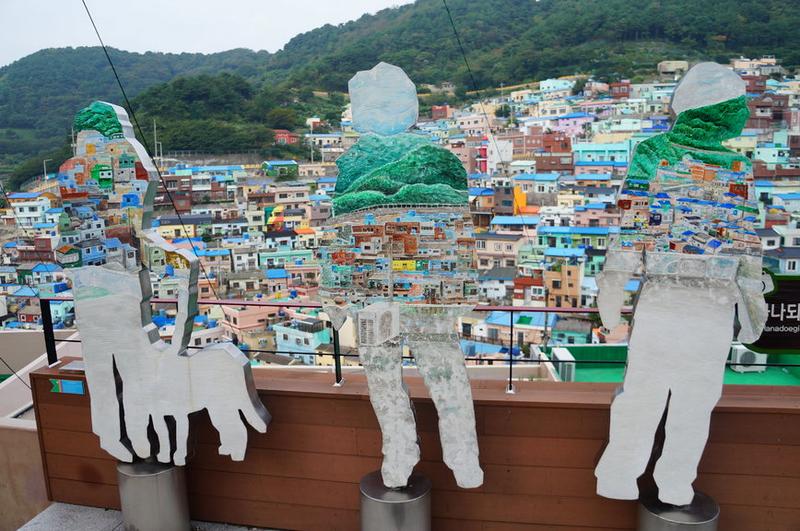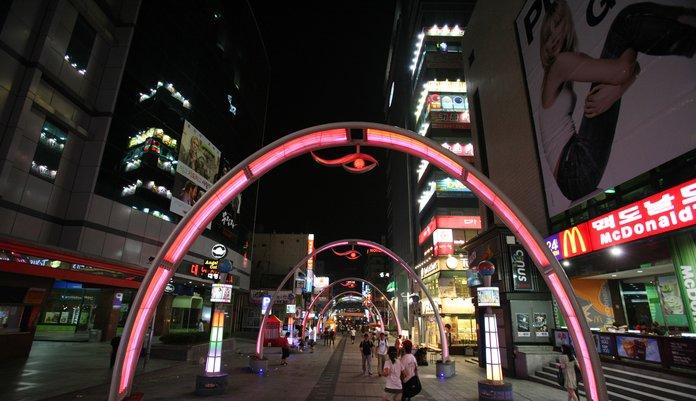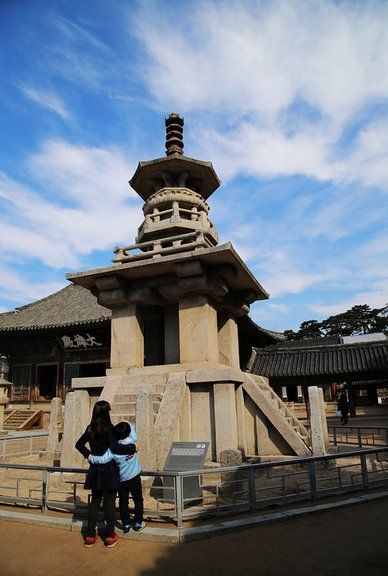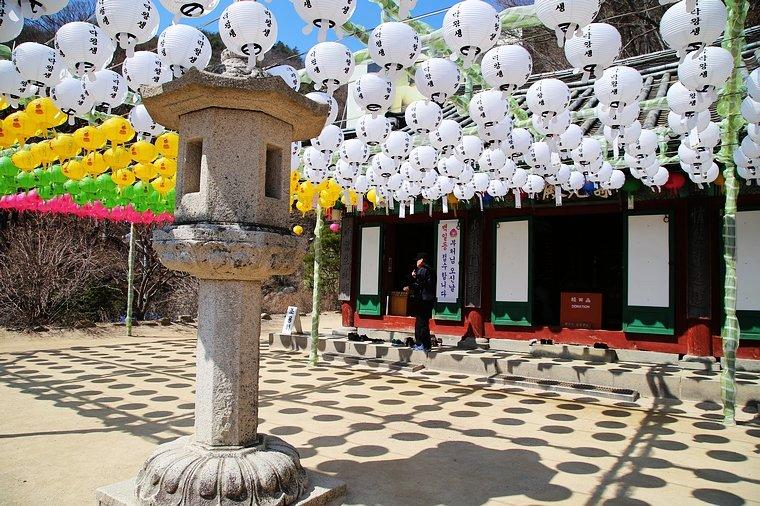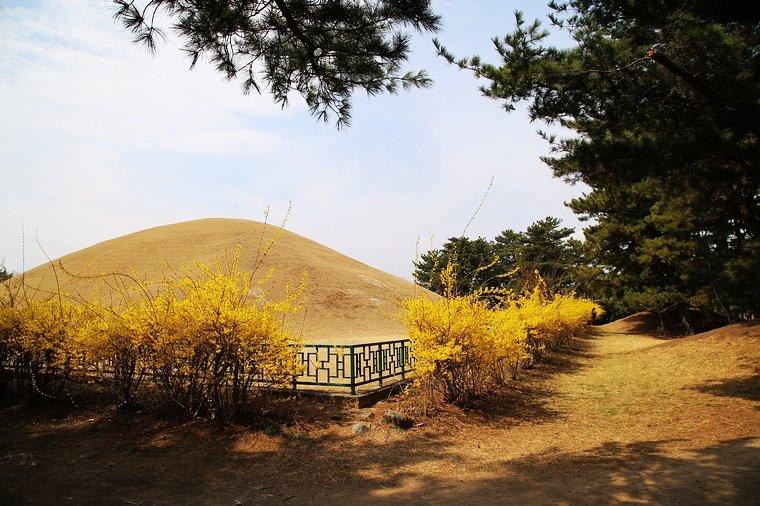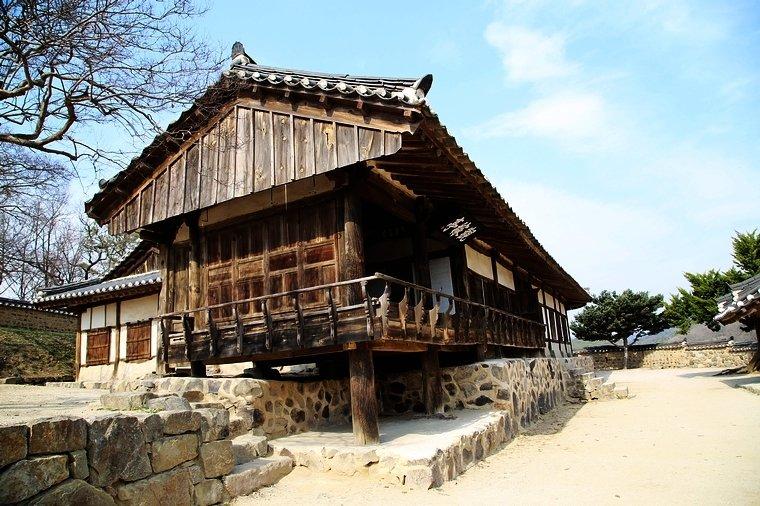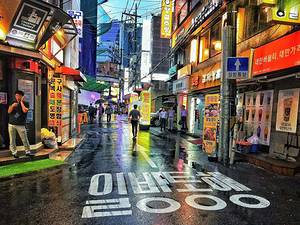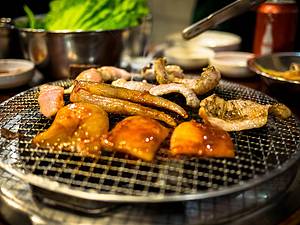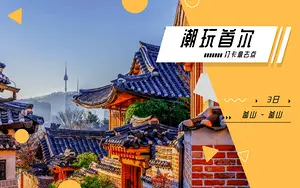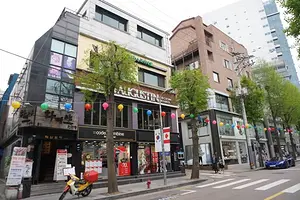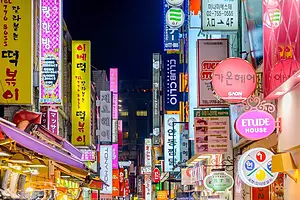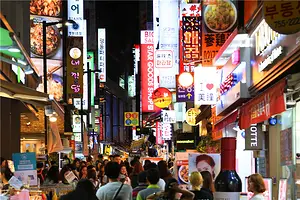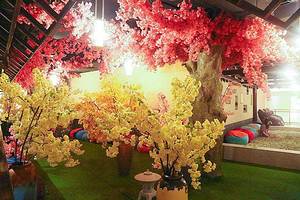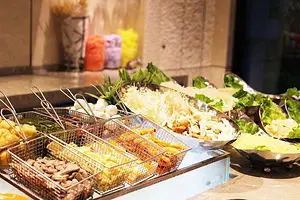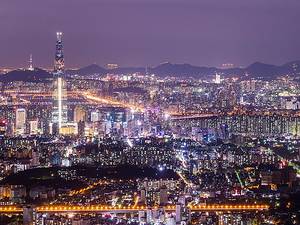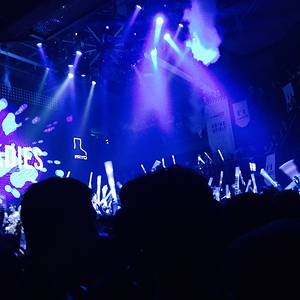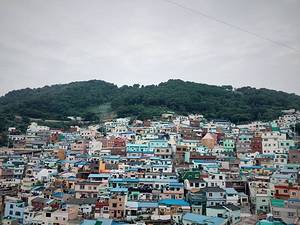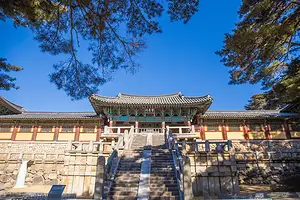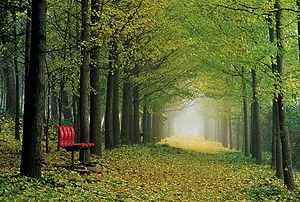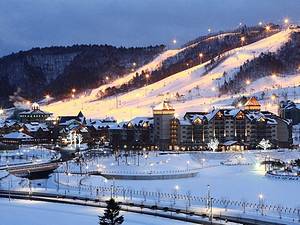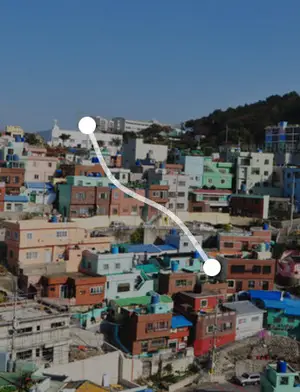9 Days Korea Tour: Seoul, Jeju Island, Busan & Gyeongju.
3 cities |
16 attraction(s) |
total distance 5156
km
 TIPS
TIPS
Day1
Day2
Day3
Day4
Day5
Day6
Day7
Day8
Day1: Seoul > Busan
5 attraction(s) ·
668 km
1
Gyeongbokgung Palace is the first palace built in the early days of the Joseon Dynasty, with a history of 600 years. It was once a grand palace and now showcases delicate beauty. Gyeongbokgung Palace is the largest of the Five Grand Palaces and features unique architecture such as Geunjeongjeon Hall and Gyeonghoeru Pavilion. In addition, there are the National Palace Museum and the National Folk Museum where visitors can explore and experience. Gyeongbokgung Palace is open to the public and there is a ticket office at the entrance of Gwanghwamun. Visitors can also watch the Changing of the Guard ceremony and take photos with the guards, immersing themselves in Korean classical culture.
The name Gyeongbokgung means "great blessings and prospering the nation," reflecting the early aspirations of the Joseon Dynasty. It was completed in 1395 and at its peak had over 390 buildings. During the Japanese invasion in the late 16th century, Gyeongbokgung Palace was burned down and remained abandoned for 273 years. It was restored during the reign of King Gojong but suffered significant damage during the Japanese colonial period, with some buildings demolished and replaced by the Government-General Building. After Korea's independence, Gyeongbokgung Palace gradually underwent restoration, with the completion of the restoration project of Gwanghwamun Gate in 2010. There are also guided tours available in Chinese, departing from the inside of the Geunjeongmun Gate at four designated times.
4
km
2
Opened in 1980, this iconic tower offers panoramic views of the city & a revolving restaurant.
330
km
3
Haeundae Beach is a famous coastal resort in South Korea, known as the representative beach of Busan. It stretches 1.5 kilometers long and is 30-50 meters wide, with an average water depth of 1 meter and an area of 58,400 square meters. The long white sandy beach, beautiful coastline, and calm waters attract a large number of visitors seeking relaxation and summer retreat. It is not only popular during the summer, but also attracts domestic and international tourists in every season. Haeundae Beach also hosts various festivals and events throughout the year, such as the Lunar New Year's Day moon viewing celebration, Polar Bear Winter Swimming Competition, sand sculpture exhibition, and Busan Sea Festival. With complete surrounding attractions and facilities, visitors can fully enjoy their vacation here. In addition, Haeundae is also recognized as one of the Eight Scenic Spots of South Korea and is considered an international-level beach resort. The hot spring foot bath pools are particularly popular among tourists, offering free services and receiving multiple awards and nominations. The 2009 movie "Haeundae" also added a touch of mystery to Haeundae Beach.
334
km
4
Blue House, the presidential office and political center of South Korea, gets its name from its unique blue tiled roof. Located in a beautiful area, Blue House is highly regarded among foreign tourists. To visit Blue House, one must apply in advance on the website and once approved, visitors must follow the staff's instructions. Photography is only allowed in designated areas and visitors are not allowed to bring food or record videos. Additionally, foreign tourists must carry their passports when visiting Blue House.
2
km
5
Insa-dong, like Shanghai's Tianzifang, is just a step away from Gyeongbokgung Palace. Although its area is not large, with only one main street and a few perpendicular alleys, it was once the residential area of the Joseon Dynasty's noble class. Today, Insa-dong is home to numerous art galleries, museums, and specialty shops. Walking on the stone-paved Insa-dong Street, history is solidified with every brick and tile underfoot, and you can experience the coexistence of classical and avant-garde Korean culture. Here, you can find a Starbucks with a Korean signboard, the most distinctive Korean souvenir store in Seoul, and traditional Korean tea shops, which are treasures of this place. It is definitely an unforgettable experience to have a cup of traditional Korean tea, taste various traditional snacks, and sit in a traditional tea house to feel the lovely atmosphere here. Moreover, you can find some Korean souvenirs that are not available elsewhere! Even locals may not be familiar with the objects in Insa-dong, but the movie "The Scandalous Lady W" by Jang Lee-yeong has added a touch of mystery and interest to this place, which is definitely worth a visit.
Day2: Seoul > Busan
5 attraction(s) ·
666 km
1
Gyeongbokgung Palace is the first palace built in the early days of the Joseon Dynasty, with a history of 600 years. It was once a grand palace and now showcases delicate beauty. Gyeongbokgung Palace is the largest of the Five Grand Palaces and features unique architecture such as Geunjeongjeon Hall and Gyeonghoeru Pavilion. In addition, there are the National Palace Museum and the National Folk Museum where visitors can explore and experience. Gyeongbokgung Palace is open to the public and there is a ticket office at the entrance of Gwanghwamun. Visitors can also watch the Changing of the Guard ceremony and take photos with the guards, immersing themselves in Korean classical culture.
The name Gyeongbokgung means "great blessings and prospering the nation," reflecting the early aspirations of the Joseon Dynasty. It was completed in 1395 and at its peak had over 390 buildings. During the Japanese invasion in the late 16th century, Gyeongbokgung Palace was burned down and remained abandoned for 273 years. It was restored during the reign of King Gojong but suffered significant damage during the Japanese colonial period, with some buildings demolished and replaced by the Government-General Building. After Korea's independence, Gyeongbokgung Palace gradually underwent restoration, with the completion of the restoration project of Gwanghwamun Gate in 2010. There are also guided tours available in Chinese, departing from the inside of the Geunjeongmun Gate at four designated times.
4
km
2
Opened in 1980, this iconic tower offers panoramic views of the city & a revolving restaurant.
330
km
3
Haeundae Beach is a famous coastal resort in South Korea, known as the representative beach of Busan. It stretches 1.5 kilometers long and is 30-50 meters wide, with an average water depth of 1 meter and an area of 58,400 square meters. The long white sandy beach, beautiful coastline, and calm waters attract a large number of visitors seeking relaxation and summer retreat. It is not only popular during the summer, but also attracts domestic and international tourists in every season. Haeundae Beach also hosts various festivals and events throughout the year, such as the Lunar New Year's Day moon viewing celebration, Polar Bear Winter Swimming Competition, sand sculpture exhibition, and Busan Sea Festival. With complete surrounding attractions and facilities, visitors can fully enjoy their vacation here. In addition, Haeundae is also recognized as one of the Eight Scenic Spots of South Korea and is considered an international-level beach resort. The hot spring foot bath pools are particularly popular among tourists, offering free services and receiving multiple awards and nominations. The 2009 movie "Haeundae" also added a touch of mystery to Haeundae Beach.
331
km
4
Many high-end international stores & restaurants draw crowds to this bustling retail district.
3
km
Day3: Seoul > Busan
3 attraction(s) ·
333 km
1
Gyeongbokgung Palace is the first palace built in the early days of the Joseon Dynasty, with a history of 600 years. It was once a grand palace and now showcases delicate beauty. Gyeongbokgung Palace is the largest of the Five Grand Palaces and features unique architecture such as Geunjeongjeon Hall and Gyeonghoeru Pavilion. In addition, there are the National Palace Museum and the National Folk Museum where visitors can explore and experience. Gyeongbokgung Palace is open to the public and there is a ticket office at the entrance of Gwanghwamun. Visitors can also watch the Changing of the Guard ceremony and take photos with the guards, immersing themselves in Korean classical culture.
The name Gyeongbokgung means "great blessings and prospering the nation," reflecting the early aspirations of the Joseon Dynasty. It was completed in 1395 and at its peak had over 390 buildings. During the Japanese invasion in the late 16th century, Gyeongbokgung Palace was burned down and remained abandoned for 273 years. It was restored during the reign of King Gojong but suffered significant damage during the Japanese colonial period, with some buildings demolished and replaced by the Government-General Building. After Korea's independence, Gyeongbokgung Palace gradually underwent restoration, with the completion of the restoration project of Gwanghwamun Gate in 2010. There are also guided tours available in Chinese, departing from the inside of the Geunjeongmun Gate at four designated times.
4
km
2
Opened in 1980, this iconic tower offers panoramic views of the city & a revolving restaurant.
330
km
3
Haeundae Beach is a famous coastal resort in South Korea, known as the representative beach of Busan. It stretches 1.5 kilometers long and is 30-50 meters wide, with an average water depth of 1 meter and an area of 58,400 square meters. The long white sandy beach, beautiful coastline, and calm waters attract a large number of visitors seeking relaxation and summer retreat. It is not only popular during the summer, but also attracts domestic and international tourists in every season. Haeundae Beach also hosts various festivals and events throughout the year, such as the Lunar New Year's Day moon viewing celebration, Polar Bear Winter Swimming Competition, sand sculpture exhibition, and Busan Sea Festival. With complete surrounding attractions and facilities, visitors can fully enjoy their vacation here. In addition, Haeundae is also recognized as one of the Eight Scenic Spots of South Korea and is considered an international-level beach resort. The hot spring foot bath pools are particularly popular among tourists, offering free services and receiving multiple awards and nominations. The 2009 movie "Haeundae" also added a touch of mystery to Haeundae Beach.
Day4: Seoul > Busan
3 attraction(s) ·
333 km
1
Gyeongbokgung Palace is the first palace built in the early days of the Joseon Dynasty, with a history of 600 years. It was once a grand palace and now showcases delicate beauty. Gyeongbokgung Palace is the largest of the Five Grand Palaces and features unique architecture such as Geunjeongjeon Hall and Gyeonghoeru Pavilion. In addition, there are the National Palace Museum and the National Folk Museum where visitors can explore and experience. Gyeongbokgung Palace is open to the public and there is a ticket office at the entrance of Gwanghwamun. Visitors can also watch the Changing of the Guard ceremony and take photos with the guards, immersing themselves in Korean classical culture.
The name Gyeongbokgung means "great blessings and prospering the nation," reflecting the early aspirations of the Joseon Dynasty. It was completed in 1395 and at its peak had over 390 buildings. During the Japanese invasion in the late 16th century, Gyeongbokgung Palace was burned down and remained abandoned for 273 years. It was restored during the reign of King Gojong but suffered significant damage during the Japanese colonial period, with some buildings demolished and replaced by the Government-General Building. After Korea's independence, Gyeongbokgung Palace gradually underwent restoration, with the completion of the restoration project of Gwanghwamun Gate in 2010. There are also guided tours available in Chinese, departing from the inside of the Geunjeongmun Gate at four designated times.
4
km
2
Opened in 1980, this iconic tower offers panoramic views of the city & a revolving restaurant.
330
km
3
Haeundae Beach is a famous coastal resort in South Korea, known as the representative beach of Busan. It stretches 1.5 kilometers long and is 30-50 meters wide, with an average water depth of 1 meter and an area of 58,400 square meters. The long white sandy beach, beautiful coastline, and calm waters attract a large number of visitors seeking relaxation and summer retreat. It is not only popular during the summer, but also attracts domestic and international tourists in every season. Haeundae Beach also hosts various festivals and events throughout the year, such as the Lunar New Year's Day moon viewing celebration, Polar Bear Winter Swimming Competition, sand sculpture exhibition, and Busan Sea Festival. With complete surrounding attractions and facilities, visitors can fully enjoy their vacation here. In addition, Haeundae is also recognized as one of the Eight Scenic Spots of South Korea and is considered an international-level beach resort. The hot spring foot bath pools are particularly popular among tourists, offering free services and receiving multiple awards and nominations. The 2009 movie "Haeundae" also added a touch of mystery to Haeundae Beach.
Day5: Seoul > Busan
5 attraction(s) ·
347 km
1
Gyeongbokgung Palace is the first palace built in the early days of the Joseon Dynasty, with a history of 600 years. It was once a grand palace and now showcases delicate beauty. Gyeongbokgung Palace is the largest of the Five Grand Palaces and features unique architecture such as Geunjeongjeon Hall and Gyeonghoeru Pavilion. In addition, there are the National Palace Museum and the National Folk Museum where visitors can explore and experience. Gyeongbokgung Palace is open to the public and there is a ticket office at the entrance of Gwanghwamun. Visitors can also watch the Changing of the Guard ceremony and take photos with the guards, immersing themselves in Korean classical culture.
The name Gyeongbokgung means "great blessings and prospering the nation," reflecting the early aspirations of the Joseon Dynasty. It was completed in 1395 and at its peak had over 390 buildings. During the Japanese invasion in the late 16th century, Gyeongbokgung Palace was burned down and remained abandoned for 273 years. It was restored during the reign of King Gojong but suffered significant damage during the Japanese colonial period, with some buildings demolished and replaced by the Government-General Building. After Korea's independence, Gyeongbokgung Palace gradually underwent restoration, with the completion of the restoration project of Gwanghwamun Gate in 2010. There are also guided tours available in Chinese, departing from the inside of the Geunjeongmun Gate at four designated times.
4
km
2
Opened in 1980, this iconic tower offers panoramic views of the city & a revolving restaurant.
330
km
3
Haeundae Beach is a famous coastal resort in South Korea, known as the representative beach of Busan. It stretches 1.5 kilometers long and is 30-50 meters wide, with an average water depth of 1 meter and an area of 58,400 square meters. The long white sandy beach, beautiful coastline, and calm waters attract a large number of visitors seeking relaxation and summer retreat. It is not only popular during the summer, but also attracts domestic and international tourists in every season. Haeundae Beach also hosts various festivals and events throughout the year, such as the Lunar New Year's Day moon viewing celebration, Polar Bear Winter Swimming Competition, sand sculpture exhibition, and Busan Sea Festival. With complete surrounding attractions and facilities, visitors can fully enjoy their vacation here. In addition, Haeundae is also recognized as one of the Eight Scenic Spots of South Korea and is considered an international-level beach resort. The hot spring foot bath pools are particularly popular among tourists, offering free services and receiving multiple awards and nominations. The 2009 movie "Haeundae" also added a touch of mystery to Haeundae Beach.
3
km
4
Bi-level highway suspension bridge with impressive views, featuring a seasonal light display.
11
km
5
Jagalchi Market is the largest fish and seafood market in Korea, offering the freshest seafood daily. As one of the must-visit tourist attractions in Busan, it is a popular destination for foreign visitors. The enthusiastic ajummas (middle-aged women) in the market, speaking in their strong dialect, invite tourists to taste the seafood. The market showcases the charm of Busan. Every year in October, the Jagalchi Festival takes place here, featuring a variety of activities, including experiential events and cultural performances.
Day6: Seoul > Busan
6 attraction(s) ·
357 km
1
Gyeongbokgung Palace is the first palace built in the early days of the Joseon Dynasty, with a history of 600 years. It was once a grand palace and now showcases delicate beauty. Gyeongbokgung Palace is the largest of the Five Grand Palaces and features unique architecture such as Geunjeongjeon Hall and Gyeonghoeru Pavilion. In addition, there are the National Palace Museum and the National Folk Museum where visitors can explore and experience. Gyeongbokgung Palace is open to the public and there is a ticket office at the entrance of Gwanghwamun. Visitors can also watch the Changing of the Guard ceremony and take photos with the guards, immersing themselves in Korean classical culture.
The name Gyeongbokgung means "great blessings and prospering the nation," reflecting the early aspirations of the Joseon Dynasty. It was completed in 1395 and at its peak had over 390 buildings. During the Japanese invasion in the late 16th century, Gyeongbokgung Palace was burned down and remained abandoned for 273 years. It was restored during the reign of King Gojong but suffered significant damage during the Japanese colonial period, with some buildings demolished and replaced by the Government-General Building. After Korea's independence, Gyeongbokgung Palace gradually underwent restoration, with the completion of the restoration project of Gwanghwamun Gate in 2010. There are also guided tours available in Chinese, departing from the inside of the Geunjeongmun Gate at four designated times.
4
km
2
Opened in 1980, this iconic tower offers panoramic views of the city & a revolving restaurant.
330
km
3
Haeundae Beach is a famous coastal resort in South Korea, known as the representative beach of Busan. It stretches 1.5 kilometers long and is 30-50 meters wide, with an average water depth of 1 meter and an area of 58,400 square meters. The long white sandy beach, beautiful coastline, and calm waters attract a large number of visitors seeking relaxation and summer retreat. It is not only popular during the summer, but also attracts domestic and international tourists in every season. Haeundae Beach also hosts various festivals and events throughout the year, such as the Lunar New Year's Day moon viewing celebration, Polar Bear Winter Swimming Competition, sand sculpture exhibition, and Busan Sea Festival. With complete surrounding attractions and facilities, visitors can fully enjoy their vacation here. In addition, Haeundae is also recognized as one of the Eight Scenic Spots of South Korea and is considered an international-level beach resort. The hot spring foot bath pools are particularly popular among tourists, offering free services and receiving multiple awards and nominations. The 2009 movie "Haeundae" also added a touch of mystery to Haeundae Beach.
14
km
4
태종대
Feel the refreshing scent of the sea as you close your eyes and let the silver-white waves wash over you. This beautiful masterpiece is created by the waves, wind, and the passage of time. When you open your eyes, the captivating scenery of Taejongdae unfolds before you, leaving you in a state of enchantment.
9
km
6
Day7: Seoul > Busan > GyeongJu
5 attraction(s) ·
407 km
1
Gyeongbokgung Palace is the first palace built in the early days of the Joseon Dynasty, with a history of 600 years. It was once a grand palace and now showcases delicate beauty. Gyeongbokgung Palace is the largest of the Five Grand Palaces and features unique architecture such as Geunjeongjeon Hall and Gyeonghoeru Pavilion. In addition, there are the National Palace Museum and the National Folk Museum where visitors can explore and experience. Gyeongbokgung Palace is open to the public and there is a ticket office at the entrance of Gwanghwamun. Visitors can also watch the Changing of the Guard ceremony and take photos with the guards, immersing themselves in Korean classical culture.
The name Gyeongbokgung means "great blessings and prospering the nation," reflecting the early aspirations of the Joseon Dynasty. It was completed in 1395 and at its peak had over 390 buildings. During the Japanese invasion in the late 16th century, Gyeongbokgung Palace was burned down and remained abandoned for 273 years. It was restored during the reign of King Gojong but suffered significant damage during the Japanese colonial period, with some buildings demolished and replaced by the Government-General Building. After Korea's independence, Gyeongbokgung Palace gradually underwent restoration, with the completion of the restoration project of Gwanghwamun Gate in 2010. There are also guided tours available in Chinese, departing from the inside of the Geunjeongmun Gate at four designated times.
4
km
2
Opened in 1980, this iconic tower offers panoramic views of the city & a revolving restaurant.
330
km
3
Haeundae Beach is a famous coastal resort in South Korea, known as the representative beach of Busan. It stretches 1.5 kilometers long and is 30-50 meters wide, with an average water depth of 1 meter and an area of 58,400 square meters. The long white sandy beach, beautiful coastline, and calm waters attract a large number of visitors seeking relaxation and summer retreat. It is not only popular during the summer, but also attracts domestic and international tourists in every season. Haeundae Beach also hosts various festivals and events throughout the year, such as the Lunar New Year's Day moon viewing celebration, Polar Bear Winter Swimming Competition, sand sculpture exhibition, and Busan Sea Festival. With complete surrounding attractions and facilities, visitors can fully enjoy their vacation here. In addition, Haeundae is also recognized as one of the Eight Scenic Spots of South Korea and is considered an international-level beach resort. The hot spring foot bath pools are particularly popular among tourists, offering free services and receiving multiple awards and nominations. The 2009 movie "Haeundae" also added a touch of mystery to Haeundae Beach.
72
km
5
Day8: Seoul > Busan > GyeongJu
5 attraction(s) ·
427 km
1
Gyeongbokgung Palace is the first palace built in the early days of the Joseon Dynasty, with a history of 600 years. It was once a grand palace and now showcases delicate beauty. Gyeongbokgung Palace is the largest of the Five Grand Palaces and features unique architecture such as Geunjeongjeon Hall and Gyeonghoeru Pavilion. In addition, there are the National Palace Museum and the National Folk Museum where visitors can explore and experience. Gyeongbokgung Palace is open to the public and there is a ticket office at the entrance of Gwanghwamun. Visitors can also watch the Changing of the Guard ceremony and take photos with the guards, immersing themselves in Korean classical culture.
The name Gyeongbokgung means "great blessings and prospering the nation," reflecting the early aspirations of the Joseon Dynasty. It was completed in 1395 and at its peak had over 390 buildings. During the Japanese invasion in the late 16th century, Gyeongbokgung Palace was burned down and remained abandoned for 273 years. It was restored during the reign of King Gojong but suffered significant damage during the Japanese colonial period, with some buildings demolished and replaced by the Government-General Building. After Korea's independence, Gyeongbokgung Palace gradually underwent restoration, with the completion of the restoration project of Gwanghwamun Gate in 2010. There are also guided tours available in Chinese, departing from the inside of the Geunjeongmun Gate at four designated times.
4
km
2
Opened in 1980, this iconic tower offers panoramic views of the city & a revolving restaurant.
330
km
3
Haeundae Beach is a famous coastal resort in South Korea, known as the representative beach of Busan. It stretches 1.5 kilometers long and is 30-50 meters wide, with an average water depth of 1 meter and an area of 58,400 square meters. The long white sandy beach, beautiful coastline, and calm waters attract a large number of visitors seeking relaxation and summer retreat. It is not only popular during the summer, but also attracts domestic and international tourists in every season. Haeundae Beach also hosts various festivals and events throughout the year, such as the Lunar New Year's Day moon viewing celebration, Polar Bear Winter Swimming Competition, sand sculpture exhibition, and Busan Sea Festival. With complete surrounding attractions and facilities, visitors can fully enjoy their vacation here. In addition, Haeundae is also recognized as one of the Eight Scenic Spots of South Korea and is considered an international-level beach resort. The hot spring foot bath pools are particularly popular among tourists, offering free services and receiving multiple awards and nominations. The 2009 movie "Haeundae" also added a touch of mystery to Haeundae Beach.
76
km
4
There are many ancient tombs in the center of Gyeongju City, but most of them are not well-preserved and have been transformed into public parks and no longer protected. The protected tombs are designated as fee-charging areas, such as Daereungwon, which has 23 ancient tombs. These tombs resemble grass-covered mounds that look like camel humps from a distance. They do not appear eerie or terrifying, but rather give a vibrant feeling. Tomb No. 155, also known as Cheonmachong, discovered in 1973, is a unique stone-cum-wood coffin tomb from the Silla period. It stands 12.7 meters high and 50 meters deep, with a stone mound constructed from piled stones. Inside the mound is a chamber measuring 6.5 meters long, 4.2 meters wide, and 2.1 meters high, made of wooden logs, with a central wooden column obscuring the view. Over 11,526 artifacts have been excavated here, including the priceless Cheonmachong mural, which is the first of its kind found in a tomb in Korea.
19
km
5
A visit to the museum is highly recommended.
A very worth visiting museum.
The museum is worth a visit.
